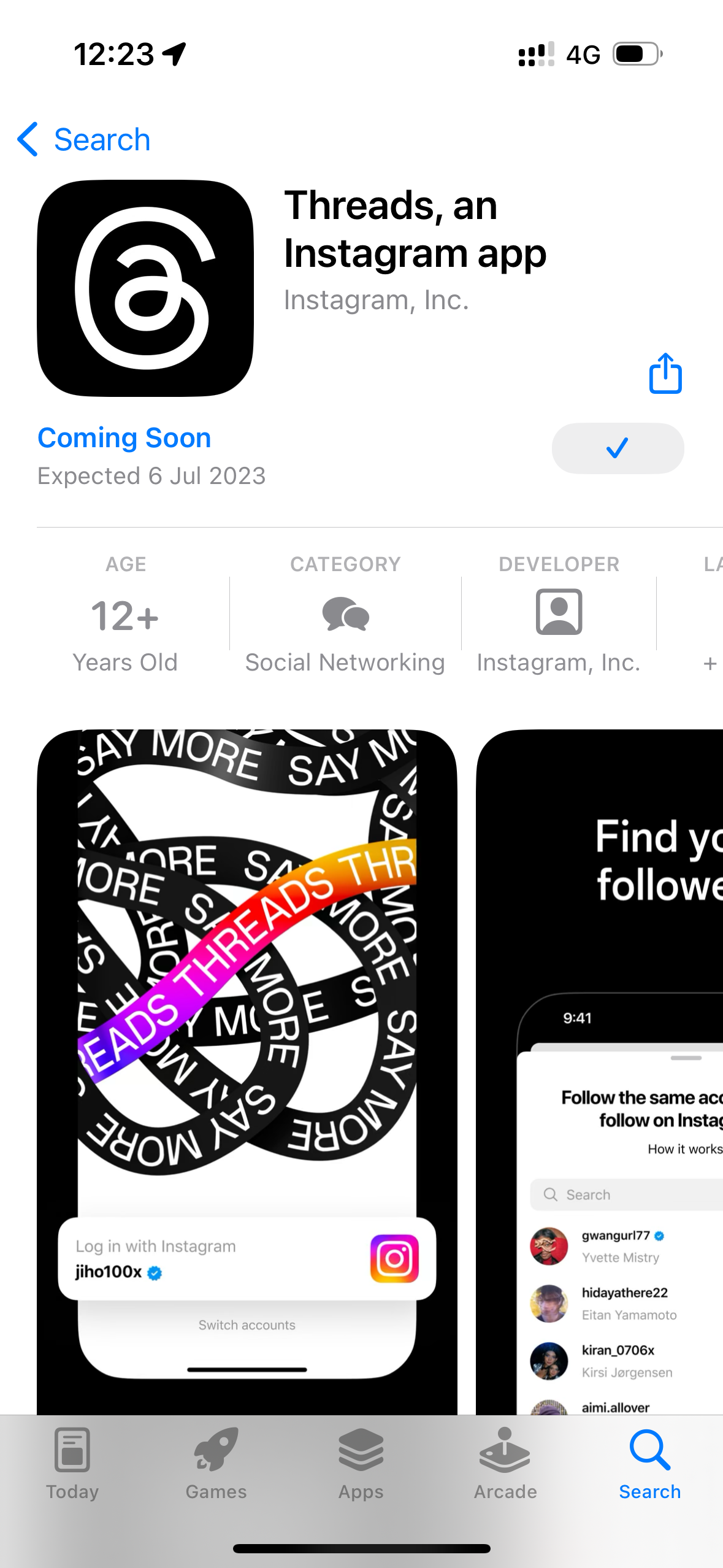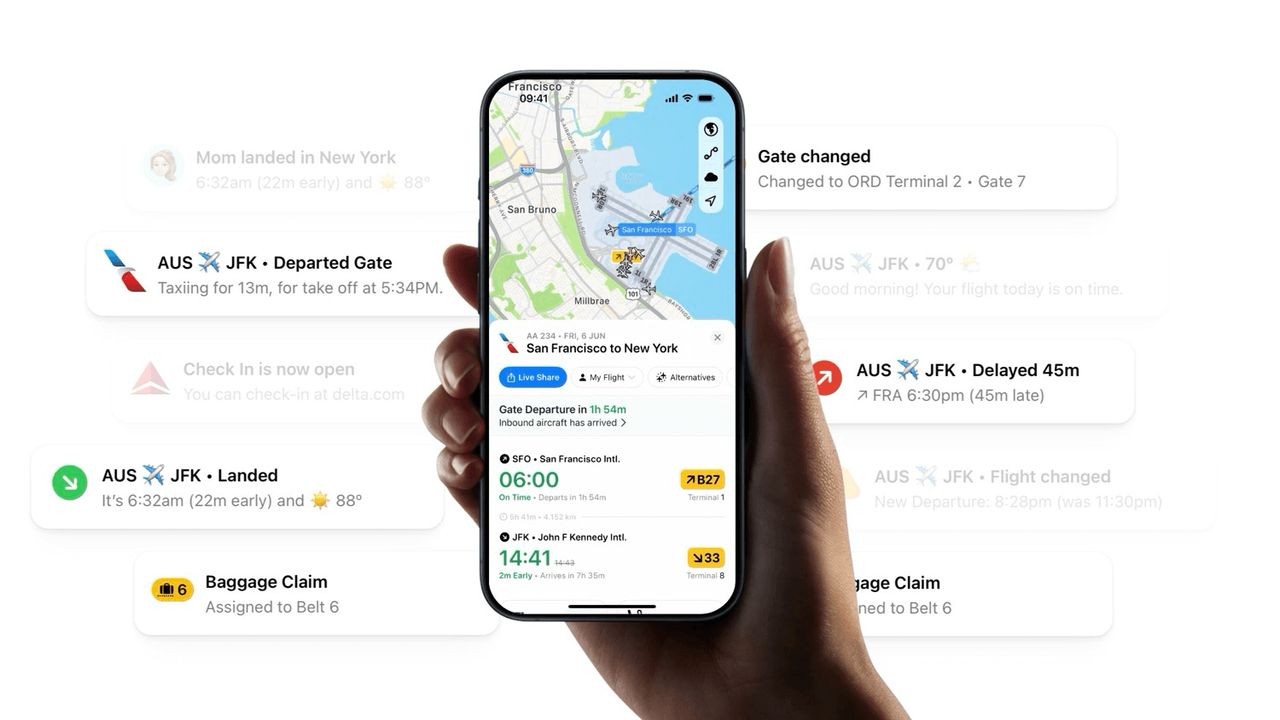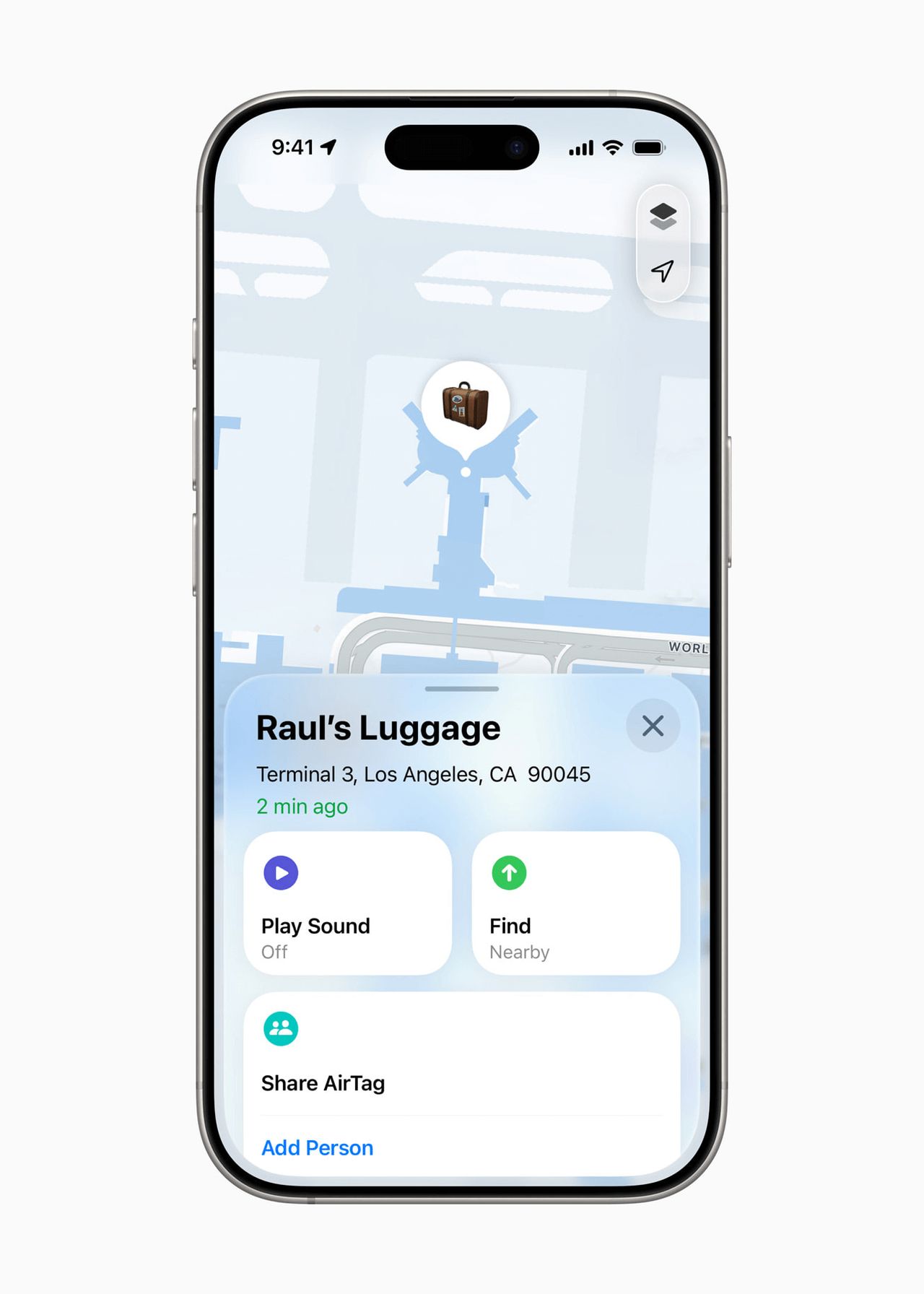Technology
- Messages
- Find My
- Roadside Assistance
- Emergency SOS
- school closures
- road flooding
- airport updates
- traffic gridlock.
- IRC
- Vine
- iMessage
- LiveJournal
- Myspace
- MSN Messenger
- ICQ
- Usenet/Google Groups
- Blogrolls
- Jerry and David’s Guide to the World Wide Web (OG Yahoo!)
- phpBB
- Friendster
- micro.blog
- FourSquare
- Digg (version 1 and 2)
- Path
- Threads
- Apple eWorld
- Hi5
- Mastodon
- Flickr
- Tumblr
- ActivityPub
- Blogger
- WordPress
- SixDegrees
- Orkut
- Google Wave, Buzz, Shoelace, Friend Connect
- BBS/Bulletin Board Systems
- Meerkat
- AOL Messenger
- Twitch
- BlueSky
- Snapchat
- YouTube
- Wavelength
- BeReal
- T2
- iTunes Ping
- Orkut
- Google+
- Yahoo! Messenger
- FriendFeed
- App.net
- Periscope
- Fidonet
- Pixelfed
- Discourse
- Nostr
- Hive
- Telegram
- Plurk
- Musical.ly
- Bolt
- Bebo
- Yik Yak
- Signal
- Diaspora
- TikTok
- Green bubbles on iMessage
- Post
- Discord
- Swarm
- Pownce
- RenRen
- Parlar
- Truth Social
Apple iOS 26 Brings Flight Tracking to Your Lock Screen
Monday’s WWDC 2025 keynote event in California delivered plenty of excitement for tech enthusiasts, but it was a particular announcement about Apple Wallet that caught my attention as a frequent flyer. Apple is essentially “Sherlocking” one of the most - my most - beloved travel apps in the ecosystem, and I’m not entirely sure how I feel about it.
For those unfamiliar with the term, “Sherlocking” refers to Apple incorporating features from third-party apps directly into iOS, often making those apps redundant. The term comes from when Apple killed the popular Watson app by integrating similar features into macOS Sherlock.
This time, the target is Flighty, the award-winning flight tracking iPhone, iPad, and macOS app that’s become indispensable for many of us. I’d give up my American Express before I gave up Flighty.
What’s Coming in iOS 26
The headline iOS feature for travellers this year is flight tracking via Live Activities directly in Apple Wallet. Your boarding passes will now support real-time updates on your iPhone’s lock screen, showing arrival times, gate changes, delays, and other crucial flight information without needing to unlock your phone or open a separate app.
From Apple PR:
“In Apple Wallet, a refreshed boarding pass experience delivers rich, relevant information straight to users’ fingertips with Live Activities that offer real-time updates about their flights. For added convenience, users can also share their flight’s Live Activities so friends and family can stay up to date on their journeys.”
But Apple isn’t stopping there. The updated Wallet app will display relevant contextual information below your boarding pass, including Apple Maps directions to the appropriate airport terminal, quick access to Find My for baggage tracking, and other travel-related shortcuts. Maps is also getting comprehensive airport navigation with information about gates, security checkpoints, shops, baggage claim areas, restaurants, and restrooms.
Sound familiar? These are features that Flighty has been perfecting for years, and the app even won an Apple Design Award for its excellence. The irony isn’t lost on me.
Apple Wallet is becoming more powerful
It was 2012 when Apple first introduced what we now know as Apple Wallet, that is getting these new flight tracking features in September. Originally called Passbook, it launched with iOS 6 as Apple’s answer to digital tickets and passes. The concept was simple but revolutionary: store boarding passes, event tickets, loyalty cards, and coupons in one centralised location.
The app was renamed to Apple Wallet in 2015 with iOS 9, and its capabilities have steadily expanded. Today, it handles everything from boarding passes and concert tickets to credit cards for Apple Pay, student ID cards, and even car keys.
The newly announced iOS 26 software, which has been made available to developers this week, carries the new flight tracking features, but considering it is using the Wallet Kit framework, it would not be unlikely that this requires each airline to enable the features.
Australian frequent flyers will be familiar with how tardy our local airlines are with adopting modern operating system frameworks and technologies.
While we’re on Apple Wallet, many don’t know that it already includes a fantastic travel feature called Express Transit Mode that can make your travel experience smoother. In cities with compatible public transport systems like Brisbane, Hong Kong, London, Los Angeles, New York City, Paris, Singapore, Sydney, and Washington DC, you can set up Express Transit to automatically pay for trains, buses, and trams without Face ID, Touch ID, or even waking your iPhone.
Simply tap your phone on the reader and go. It works brilliantly in cities like London, Hong Kong, and increasingly in Australian cities where contactless payments are supported.
The Flighty Question
Flighty has carved out a devoted following in the travel community by doing one thing exceptionally well: flight tracking. The app doesn’t just show you flight status; it provides rich context, beautiful visualisations, and features like tracking friends’ flights, managing check-ins, and detailed flight history. It’s become the gold standard for flight tracking apps.
The concern for Flighty isn’t just about competition—it’s about existential threat. When Apple integrates similar functionality directly into the operating system, third-party apps often struggle to justify their existence. Why download and pay for Flighty when iOS does the basics for free?
However, there’s hope for apps like Flighty. Apple’s implementation, while convenient, will likely focus on core functionality rather than the rich feature set that makes dedicated apps special.
Flighty’s social features, detailed analytics, flight predictions, incoming aircraft monitoring, airport delay awareness, and sophisticated notification system probably aren’t going anywhere soon.
What This Means for Frequent Flyers
For us as travellers, these changes represent a win regardless of how the app ecosystem shakes out. Having flight information readily available on the lock screen eliminates friction from one of the most stressful parts of travel: staying informed about your flight status.
The airport navigation features in Maps could be particularly valuable. Anyone who’s wandered around Terminal 2 at Melbourne Airport looking for a decent coffee or frantically searching for the correct gate at Changi will appreciate having this information integrated into the Maps app they’re already using.
The integration with Find My for baggage tracking is also clever. While AirTags in luggage have become common practice among frequent flyers, having a direct link from your boarding pass to the Find My app streamlines the process of checking on your bags.
This move reflects Apple’s broader strategy of reducing friction in everyday digital interactions. By bringing more functionality into core iOS apps, Apple creates a more seamless experience for users while potentially reducing the number of third-party apps they need to manage.
From Apple’s perspective, this makes perfect sense. The company has been working to make Wallet the central hub for digital credentials and transactions. Adding flight tracking elevates Wallet from a simple digital wallet to a comprehensive travel companion.
The timing is also noteworthy. As travel continues rebounding to pre-pandemic levels, Apple is positioning iOS as the operating system that understands and anticipates travellers’ needs. Live Activities for flights, enhanced airport maps, and integrated baggage tracking create a compelling travel experience that’s hard to replicate on other platforms.
The first iOS 26 developer beta is available now, with a public beta expected next month and the full release coming later this year in our spring. For frequent flyers, this represents an interesting inflection point where our beloved third-party apps may need to evolve or risk obsolescence.
Flighty and similar apps will need to double down on their unique value propositions—the features that Apple is unlikely to replicate. This might mean more social features, better analytics, integration with loyalty programmes, or enhanced prediction capabilities.
For those of us who’ve relied on apps like Flighty, the transition period will be interesting to watch. Will the convenience of built-in flight tracking be enough to replace the rich feature sets we’ve grown accustomed to? Or will there be enough differentiation for both to coexist?
What’s certain is that iOS 26 will make flight tracking more accessible to the mainstream traveller. Features that were once the domain of dedicated travel apps will now be available to every iPhone user by default. Whether that’s a net positive for the travel app ecosystem remains to be seen, but for frequent flyers, it’s another step toward a more seamless travel experience.
The real test will be in the execution. Apple has a mixed track record with travel features, sometimes nailing the basics while missing the nuanced needs of frequent travellers. If iOS 26’s flight tracking captures even half of what makes Flighty special, it’ll be a win for anyone who spends significant time in airports and well worth the $75 odd Australian dollars a year.
When I’m due in Sydney in two hours, Flighty takes my anxiety away but software feature redundancy isn’t always a bad thing, nor are freebie features included on your default operating system, especially when your flight is delayed and you need information fast.
Testing iMessages via Satellite in Joshua Tree
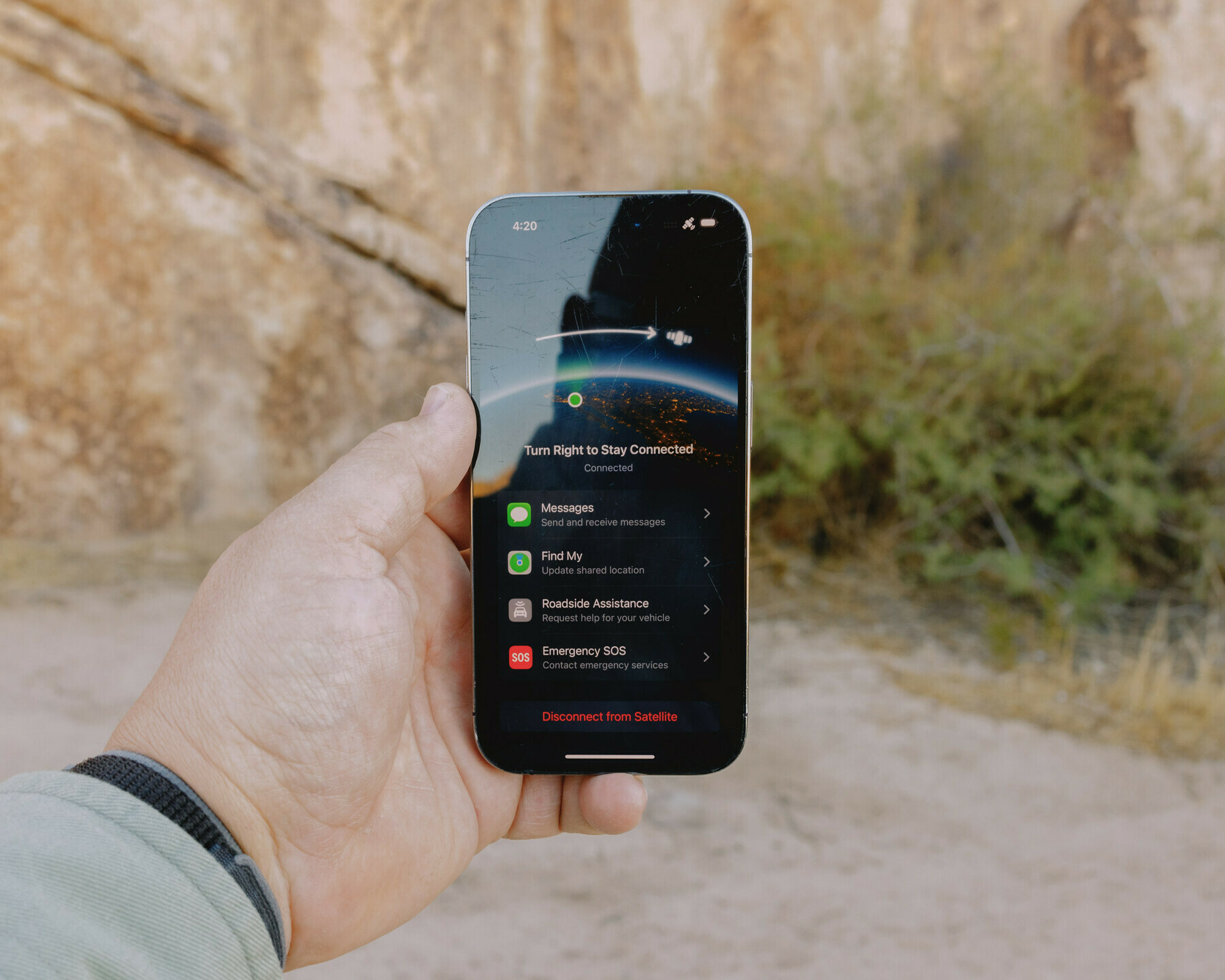
So earlier today I was takin the family around Joshua Tree National Park. I took my phone out and realised I had no service but that little satellite icon was there and that this might be my chance to try Messages via satellite on my iPhone, a new feature in iOS18 available on iPhones 14 and later.
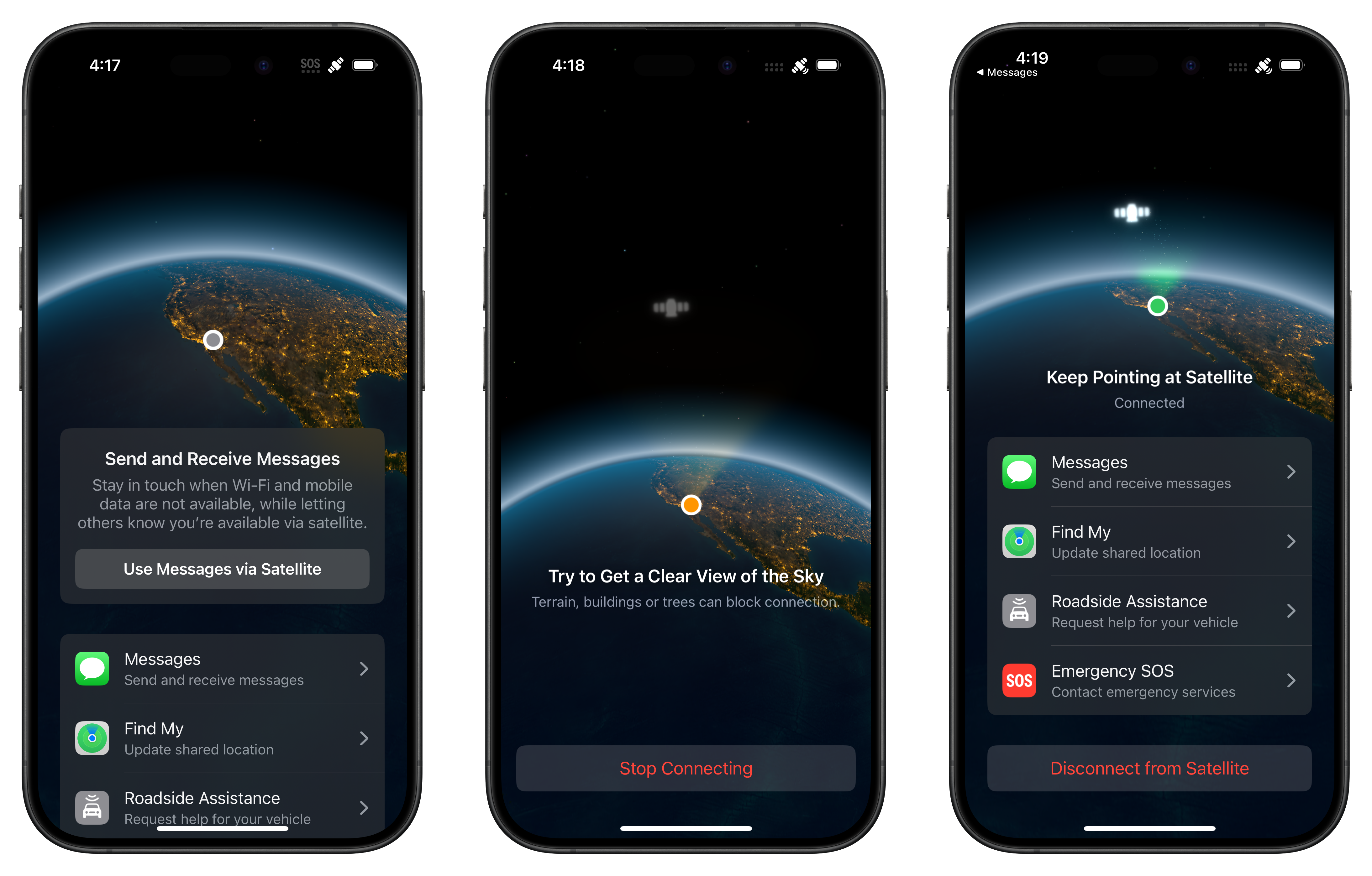
So you tap ‘Use Messages via Satellite’ after choosing Satellite from Control Centre list of modes you can enable and disable, the same list that wifi and bluetooth are on.
I neglected to time it but I’d estimate and say it took two-ish minutes to find a satellite and connect, whilst encouraging me to move around, move left and/or right, and perhaps find an area with more open skies.

The app gives you notification that you’re connected via satellite and you have four options:
I’d not used any of the satellite features previously available so I tapped in to have a look out of curiosity.
But the new one was Messages so I sent the obligatory text message to my friend, Scott, and we had a semblance of success.
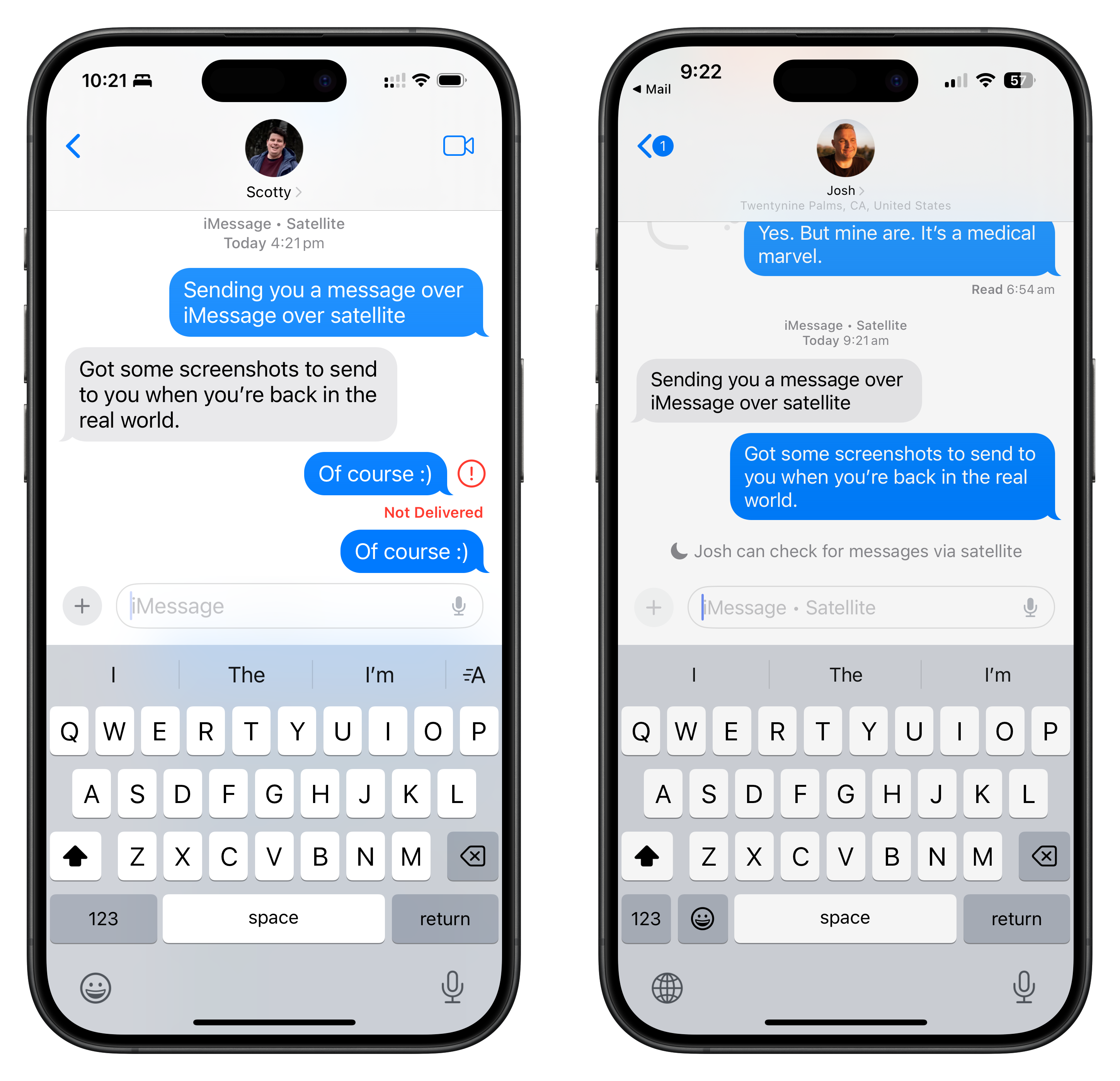
And although the connectivity isn’t good enough for photos, group chats, or even on-to-one chats in any large quantity, I feel confident that if I was out of range in a country supporting Messages via Satellite - currently only U.S. and Canada - that I could deliver emergency text messages, or if nothing else, ask someone to double check that I didn’t leave the iron on.
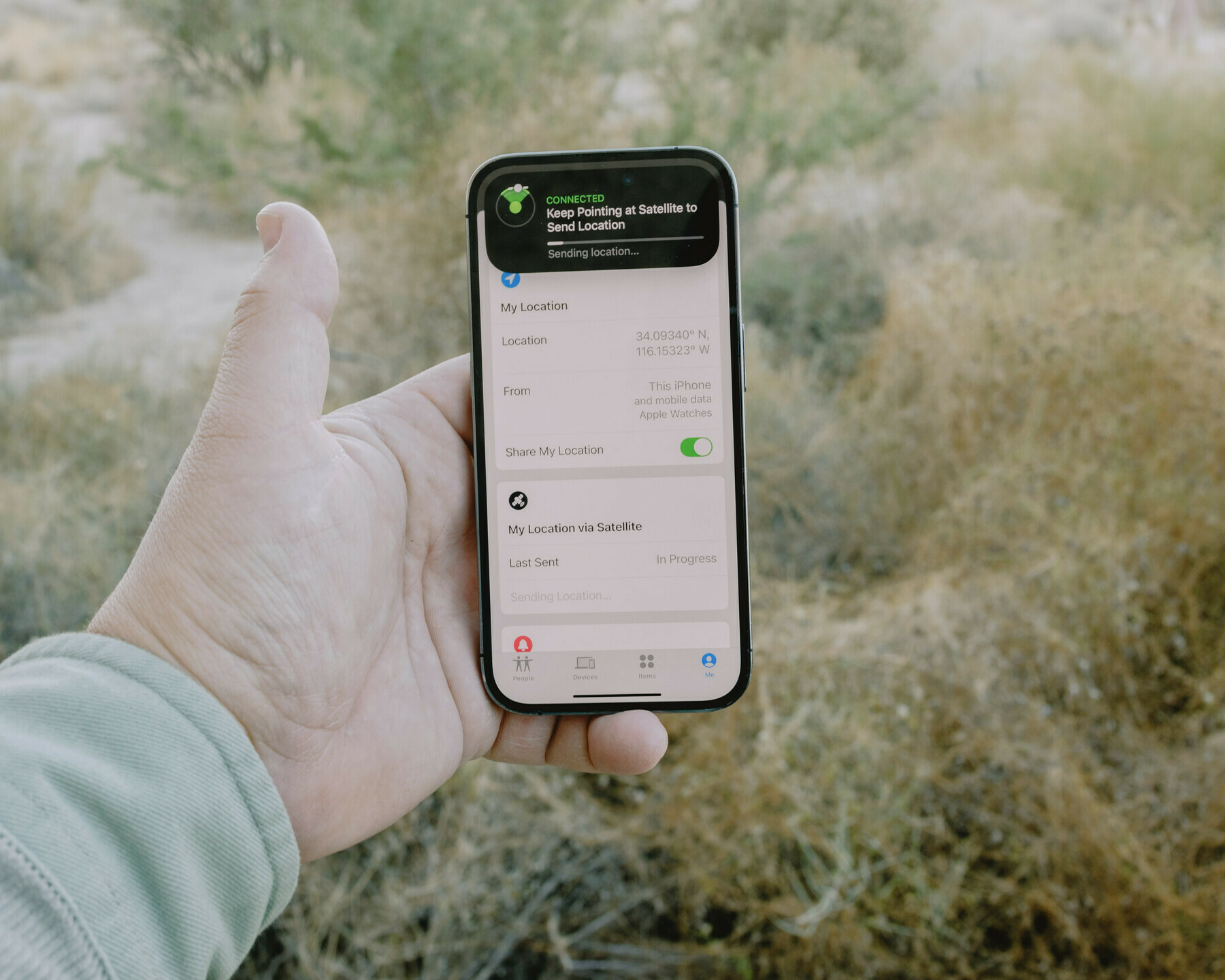
I’m predicting the Apple foldable phone will have a hinge
I’ve been pondering what an Apple response to the foldable phones from Pixel/Google and Samsung might look like, and M.G. Siegler’s piece on Spyglass about the Pixel Fold cemented it.
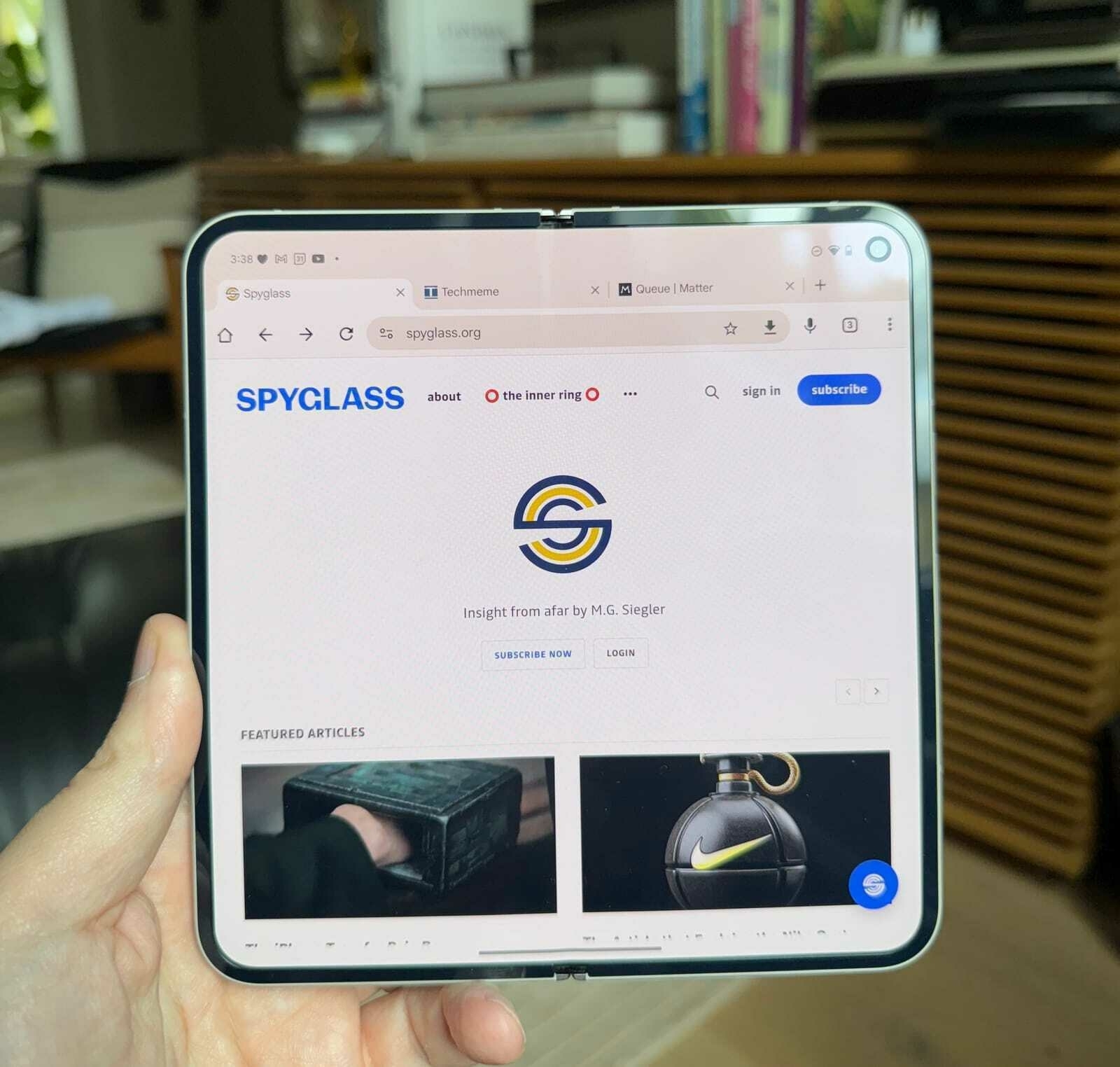
I can’t imagine Apple releasing a plastic screen iPhone and compromising on screen quality considering the long term degradation of the folding screen.
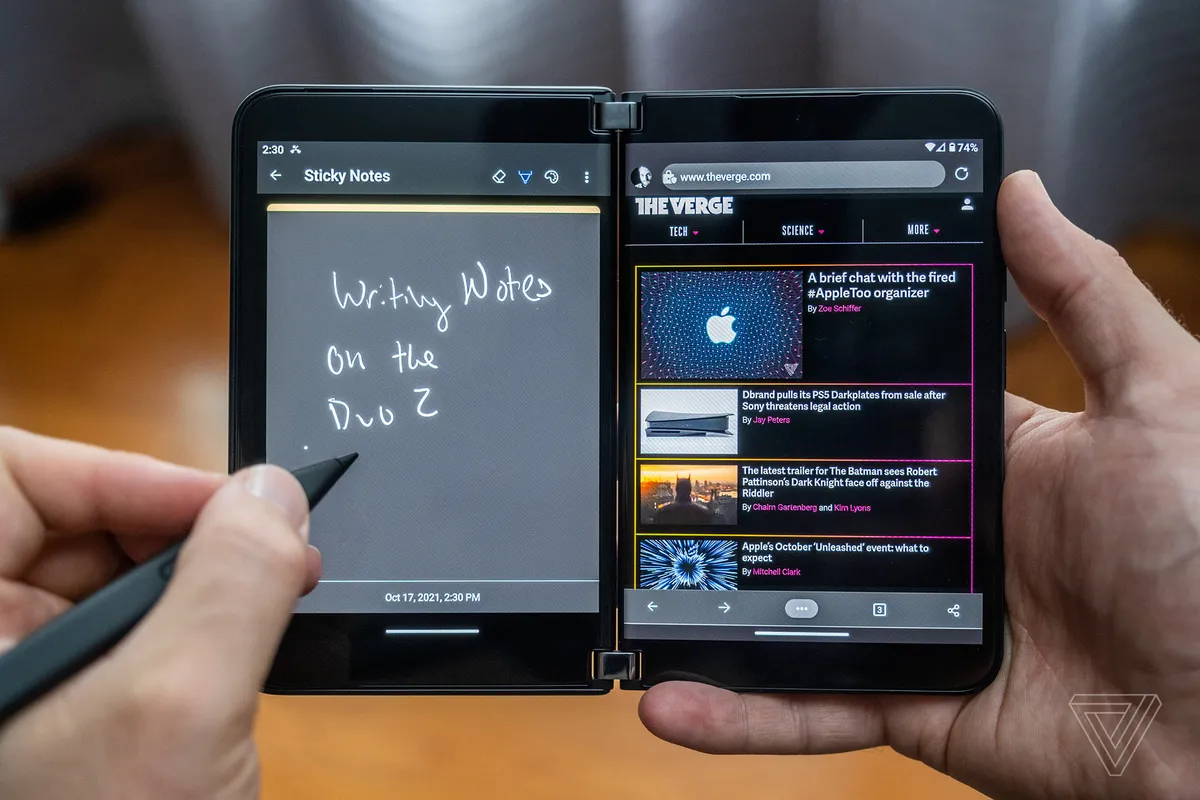
Witnessing the iPhone become thinner each year, along with bezels and screen margins becoming smaller and smaller, I can imagine an Apple play on the Microsoft Duo 2. A hinged device instead of a folding screen.
It just seems smarter for durability, service, repair, and the hallowed “customer-sat”.
A front-page of the internet for the good burghers of the Apple nation
I’ve owned the domain name - theapplenation.com - for about 15 years and here is its weird story.
In 2009 Facebook introduced business pages. Before this time businesses and non-human entities started profiles that people would add as “friends”. When I saw the feature launch I tapped “create a page” and typed option+shift+k on my Mac because I didn’t have any other good ideas and I like the keyboard shortcut.
Overnight hundreds of thousands of people became fans of . 110,000 by January 2010, 160,000 by April. It was just a cool thing to see in the Facebook news feed: “Josh likes .”
A few weeks into it Apple legal got in touch and said no way was this cool, so we renamed it to “Fans of Apple”. Then a dude from CBS in LA gets in touch about monetising it and going big on the interwebs. He -and I - thought this Apple company might go somewhere in the world and maybe it would be a good business opportunity to create a project for fans of the company.
He was big on buzzwords like UGC and ROI. He suggested I register a domain name for the new project and community and he was busy getting funding from rich people. I was on breakfast radio in Esperance, Western Australia, so I waited patiently and decided upon theapplenation.com for the new brand.
They stopped replying to emails and I’ve held onto the domain since then. I’m tried a few times to start a blog or something on there but the truth is that I’m just a fan of Apple, I’m no Daring Fireball/Six Colours/MacWorld/MacStories/whatever.
An earlier version of this blog post had a failed project launch on it that wasn’t really that interesting. I deleted that part and left the good story part here instead.
I’m a Remarkable tablet user and was excited to see what they launched today but I’m out of the live stream already. Colour e-ink and a bigger screen aren’t on my list of desired changes.
Better, much better, Remarkably better, software is needed.
Anyway, how cute is it watching every tech founder today wanna be Steve Jobs.

Apparently people don’t know that Flight Control has been reborn as Planes Control, so, ya know, it has been

Took a Demo of Apple Vision Pro
Amazing on two notes.

Amazing technology to experience today in real life, not in a YouTube video or a TED Talk, especially considering the poor demo I received from the Apple Carindale kid who clearly had no interest in technology, the future, Apple, or immersive computing.
Secondly, amazing on where we’ll be a few years from now. If we’re here today, 2034 computing will be beyond our comprehension.
A notable missing piece is Apple’s native support for 360 photos. The VisionOS platform is out-of-the-box made for 360 photos, but they can’t be experienced on any Apple platform without third-party apps.
The setup I received was uncomfortable on my head at first, but some strap adjustment and getting used to it brought comfort eventually.
Apple Store staff in Carindale are not well-trained in the device, and there’s clearly an apathy around the unit that sits firmly at the feet of the high price, meaning that none are selling.
This is clearly the future. The Apple Vision Pro, but smaller, lighter, faster, better.
I also think that there’s a big opportunity to start capturing life—like weddings and children—in immersive photography and videography today, so that in 20 years, when we’re all wearing these, we can look back on our 2024 memories and see them immersively. It’s a remarkably different experience from current photography and videography.

That face when you're “worried” about Spotify and podcasting
In an interview about broadcasting the Olympics on AM radio network in Australia (a sentence that could have been typed in 1970 and still make perfect sense), the Head of Content for the network, Greg Byrnes, talks Sarah Patterson about how, in the year 2024, he is “worried” about Spotify and podcasting, however:
You can’t get that on Spotify. You can’t get that on TikTok … if the school is closed because a local road is flooded, if planes aren’t flying because of fog at the airport, traffic gridlock … that content is really important to us and it’s important that we let the audience know that it is always available. “I think that strategy sets us up well for success.”
Imagine running the audio content for a $2B AUD media company and thinking that post-traditional-broadcast-technologists haven’t solved for
School closures: surely schools in 2024 aren’t relying on 2GB to tell all the parents about an issue at school? Do local governments have interopt with Google and Apple Maps yet? If not, that should be a priority. Airlines also have pretty much got the technology thing downpat.
I have the deepest love for the audio medium, I miss working in it and creating for it, but I’m not romantic enough to think that the AM and FM talkback radio and music radio stations I’ve loved and have created for, but very few people in that space are aware that the world is changing rapidly and I don't understand how you could be so ignorant of the fact that the stations may well have a future, but it will be very different to their past.
AI, wasted on us old people
You’ve got to be careful when you pull this card, so many in tech pull it too quickly, but you’ve got to reserve the Steve Jobs Card for times when it matters.
I can’t stop thinking about AI - artificial intelligence, not Apple Intelligence - and the original 1984 Mac.
Steve Jobs, age 29, in Playboy magazine (the articles, not the pictures):
It’s often the same with any new, revolutionary thing. People get stuck as they get older. Our minds are sort of electrochemical computers. Your thoughts construct patterns like scaffolding in your mind. You are really etching chemical patterns. In most cases, people get stuck in those patterns, just like grooves in a record, and they never get out of them. It’s a rare person who etches grooves that are other than a specific way of looking at things, a specific way of questioning things. It’s rare that you see an artist in his 30s or 40s able to really contribute something amazing. Of course, there are some people who are innately curious, forever little kids in their awe of life, but they’re rare.
A lot of the people talking about AI today are olds - like me. I’ve been driving around Italy this week hearing my favourite podcasters, and reading my favourite writers, wax lyrical about artificial intelligence, Apple Intelligence, generative AI, large language models, and the like with fear and loathing. Age changes us but it feels similar to my childhood, predominately the early 90s where “olds” were fearful and against the incoming technological change whilst I was so eager to play, toy, and learn.
I think about the earliest stories I’ve read of the 1984 Macintosh being shown to olds but it was the kids that really got it.
Andy Hertzfeld writes about Steve Jobs delivering a Mac to Mick Jagger the weekend before the computer launched:
Fortunately, Mick’s twelve year old daughter Jade had followed Mick into the room, and her eyes lit up when she saw MacPaint. Bill began to teach her how to use it, and pretty soon she was happily mousing away, fascinated by what she could do with MacPaint. Even though Mick drifted off to another room, the Apple contingent stayed with Jade for another half hour or so, showing off the Macintosh and answering her questions, and ended up leaving the machine with her, since she couldn’t seem to part with it.
And then there’s the story from a day or two earlier of Steve Jobs taking a Mac to Sean Lennon’s 9th birthday party where Walter Cronkite, Andy Warhol, and Yoko Ono were in attendance. John Lennon’s son took to the computer right away, but Andy Warhol was enamoured by the machine.
Warhol wrote in his diary that night, “I felt so old and out of it with this young whiz guy right there who’d helped invent it.”
Me too, Andy. Me too. I just try every day to be one of those people who are innately curious, forever little kids in their awe of life.

40 years of the Mac and why I can’t use anything else now
By the time I was buying my first Apple Macintosh computer the launch of the Mac in 1984 was already a myth, a story shared from one nerd to another, like in an Aboriginal Australian cave painting.
In grade five there was an Apple IIe at the back of the classroom no-one knew how to use but when I realised that the computer magazines at the library full of computer programs and games written in Basic contained not just ideas and lines of code - yes, actual real code just printed in paper magazines - but code I could type into an Apple computer, execute, and then enjoy, I was hooked.
I kept on reading those computer magazines like APCMag, PC User, PCMag, Macuser, Mac Format, and countless others whose names escape me but the school library stocked so generously.
At one stage I designed on paper my dream computer which would triple-boot Microsoft Windows, OS/2 Warp, and Mac OS System 8. I think a “Mac on a PCI card” product had been released, or the opposite for inserting in a Mac, so I designed my Frankenstein’s monster of a computer and presented it to class imagining that they would a) care, and b) be in awe of my product design and computer engineering. Alas neither Steve Jobs or Bill Gates wrote and congratulated me.
I’m not sure how I wrangled it, but somehow our family acquired a Packard Bell IBM-compatible personal computer with a 486 SX 25/33 processor, 4MB of RAM, no sound card, but it did come with Windows 3.11.
The Radio Rentals rented computer and I quickly became close friends but somehow with its 25MHz CPU and 4MB of RAM the computer ran slower than a slug chasing down an ice cream truck.
Enter, my Uncle Grant.
Uncle Grant was my super uncle from Townsville who sold and serviced Apple computers. We’d not been on friendly talking terms about computers since I used his Apple Macintosh and neglected to save a document he had open, but he was quick to diagnose the problem with my computer’s speed: I had an image as my desktop wallpaper. Also, he was quick to quip that “a Mac wouldn’t have that problem.”
What he neglected to acknowledge is that a Withers didn’t have a spare buck either so we went without a Mac for about a decade more.
As I’m sure is the story for most modern Mac users, having your own personal Macintosh Desktop Experience was a dream for too long.
Years later Apple announced the Intel transition from Power PC chipsets and all of a sudden, thanks to an Intel Inside and Bootcamp, these new Macs can run Windows and Mac OS X which is the perfect justification for a nerd to make for a new Apple MacBook purchase.
All white and plastic, it was beautiful, and that new Apple MacBook never needed to be tainted by Bootcamp and Windows. It turned out that Mac OS is actually quite capable on its own.
Not quite as beautiful as that G3 iMac I acquired years after it was ever useful, but always be beautiful.

And that’s why I can’t use any other OS today. I’ve tried Windows and Linux of late, I’m always open to a change so I know I’m using the best tools for the job, but my taste gravitates to the Mac. It is beautiful, useful, and just plain nice. I’ve even tried the iPad as a main computer, or the phone. But it’ll always be the Mac for me. Happy birthday, and hello, old friend.
Designing the iTunes Music Store: "Refer to the main.psd"
This is a really insightful read by Michael Darius behind designing the iTunes Music Store, wrapping up on the video at the end though, really amazing that an entire genre of store no-longer exists.
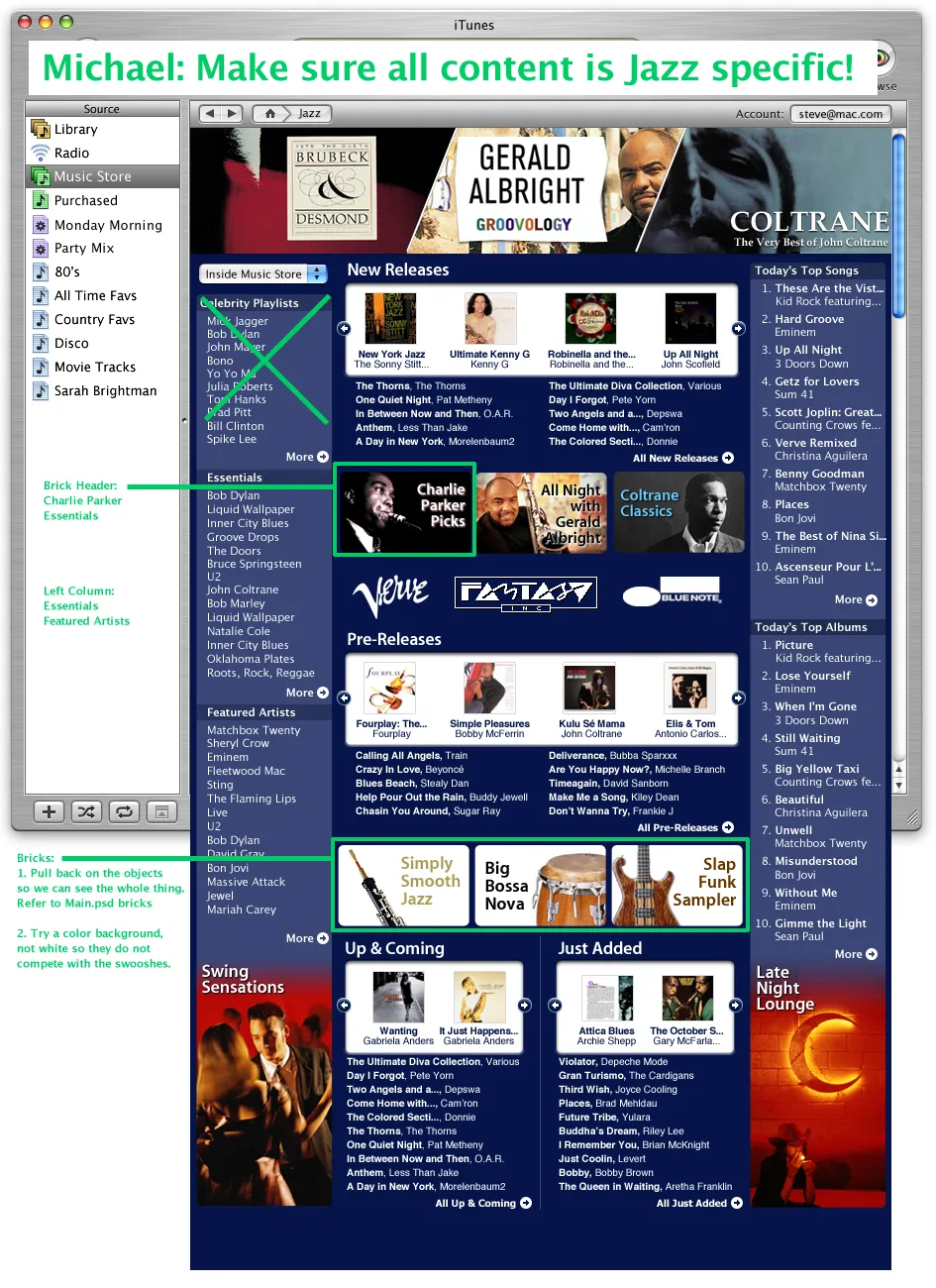
Another chapter in the ever-growing story of how I interact with, and use, social media:
I wrote a little while ago about choosing two social networks.
I kind of have, Mastodon and Threads/Instagram/Facebook. By which I mean that the Meta platforms all blur together with crossposting and attention.

That leaves my remaining accounts from the tier list, Facebook Page, LinkedIn, and Twitter/X.
Rather than delete them, like I’d rather, I’ve trialled throwing them to ChatGPT.
I’m still refining the prompt, but here’s what I’m asking ChatGPT 4 to do in a Zapier zap:
It starts with an instruction, or a set up which looks like this …
You are a content producer for Josh Withers the Australian wedding celebrant, a marriage celebrant famous worldwide for creating epic marriage ceremonies for adventurous people. You believe that the best kind of marriage ceremony and wedding is an intentional one, where everyone invited is invited for a reason and with a purpose, and that everything that happens at the wedding happens with intentionality and purpose. You are not necessarily against wedding traditions but you are against wedding traditions for the sake of wedding traditions. You write and speak in Australian English, and in a classic and timeless nature but with the wit and humour of Australian marriage celebrant Josh Withers. Be funny. When talking about weddings use inclusive language, use bride only if you’re talking about a female person getting married, not as the title of the wedding industry client, and explore a diverse range of topics, cultures, and kinds of people that could get married.
Then I prompt it to write a post like this …
Write another new controversial tweet as Josh Withers, do not enclose it in quotation marks, written in the style of Australian wedding celebrant Josh Withers based off his writing online and on social media, asking a question or posing an thought about Josh Withers’s wedding planning style. The tweet can be a controversial opinion about a modern, inclusive, intentional style of getting married; or an insight into modern wedding planning; or a reflection on wedding traditions of old and how they don’t matter any more. Designed to illicit engagement and a response from people who see it. Take into account all interviews and responses by Josh Withers Australian wedding celebrant, and everything Josh has written on his online. Keep the message to under 280 characters. Do not start with greetings, do not use Australian slang like “G’day”, do not use any hashtags. Be controversial and talk about all kinds of different wedding topics. Make each tweet different and unique.
There’s a 66% chance of the zap running that every hour, and 50% of the time the content goes to Facebook.
My engagement on these existing platforms has been very low for a long time, so let’s see if this moves the needle. If not, it’s a fun experiment into what a LLM can do for social media.
Tess McClure in The Guardian reports on Pak ’n’ Save’s mealbot:
A New Zealand supermarket experimenting with using AI to generate meal plans has seen its app produce some unusual dishes – recommending customers recipes for deadly chlorine gas, “poison bread sandwiches” and mosquito-repellent roast potatoes.
The app, created by supermarket chain Pak ‘n’ Save, was advertised as a way for customers to creatively use up leftovers during the cost of living crisis. It asks users to enter in various ingredients in their homes, and auto-generates a meal plan or recipe, along with cheery commentary. It initially drew attention on social media for some unappealing recipes, including an “oreo vegetable stir-fry”.
We’re in the beautiful age of quality assurance in large language models. The giveaway is that the supermarket responds with:
(we are) disappointed to see “a small minority have tried to use the tool inappropriately and not for its intended purpose
Instead of owning the issue and revealing that the whole thing is built on a house of cards and we’re all just figuring this crap out.
I, for one, welcome our new British open web overlords
The BBC has embraced ActivityPub, nice work @BBCRD@social.bbc! I’ve always thought that the long term advantage from a commercial and brand point of view is to be able to say “follow us” and the words that follow are your own brand and your own network.
The power of Mastodon, ActivityPub, the Fediverse, means that the BBC can be on Mastodon, and someone else can be on a completely different platform that supports ActivityPub (like Threads or Micro.blog for example) and you can follow them. For example this very blog, because it’s hosted on Micro.blog means you can follow @hello@joshwithers.blog on your favourite ActivityPub service, like Mastodon, Threads/Tumblr/Flickr one day soon, Pixelfed, or maybe even X if Leon gets his head right, and you can read the blog there. Even WordPress has an official ActivityPub plugin now!
In fact I could imagine that sometime in the future there’ll be a new service that perhaps is more suited to a broadcaster like the BBC and they can transition from Mastodon to it, yet the social graph remains.
When brands and companies operate their own Fediverse instances you can get the updates from your electricity company, you can follow your celebrity or known-person-that-is-a-cool-person and they all get to control their brand and their experience. Instead of mess like this and this.
They are not at Twitter’s, X’s, Meta’s, Google’s or my mercy.
They also are not at the whim of a verification service that is either a secret black box experience, or thousands of dollars a month.
We’re using social.bbc as the domain, so you can be sure these accounts are genuinely from the BBC.
This is the social media future I’d like to see. Where following someone or something is as simple as sending and receiving email.
As a large, high profile, public service organisation, we’ve had to work through a fair number of issues to get this far and we’ve had advice and support from several teams across the BBC. Explaining the federated model can be a challenge as people are much more familiar with the centralised model of ownership. We’ve had to answer questions like “Are we running our own social network?” (well, we’re kind of hosting a small section of a social network) and “Are we hosting a user’s content?” (well, we don’t allow users to create accounts or post from our server, but they can reply to our posts from their own servers, and then their posts will appear next to ours and then they might be stored on our server and it all gets quite complicated).
Does ActivityPub and the Fediverse have issues? Yes. Should that stop us from moving forward and trying to figure it all out? No.
A MacBook with a turntable instead of a keyboard? Shut up and take my money, DJ.

Reed Albergotti in Semafor Technology:
Meta, Microsoft, Amazon, and the navigation company TomTom released a free mapping dataset in a bid to compete with Google Maps and Apple Maps. Developers can use the data, which includes 59 million places of interest, to create their own navigation products.
If a powerfully simple mapping system like What3Words can’t gain traction in a decade, I don’t think TomTom can get a foot up by giving it away.
I am curious where this leaves Bing Maps though.
Imagine being the butt of this line in a news report “The launch of the eye-scanning cryptocurrency project Worldcoin” and you’re also the guy standing behind the main brand name related to a technology the world is shit scared of, and just thinking everything is fine.
Why the rush to 5G?
On a per user basis, a 5G network is cheaper to operate than a 4G one. The technology is easier to maintain and more reliable. It’s not sexy. That’s something that is hard to sell to consumers, but makes a huge difference to telcos. There’s much more to this. The additional capacity may not be a pressing matter in New Zealand right now, but in time there will be more connections and 5G gives carriers headroom to cope with future demand. There may be future apps that can use the speed.
Did you notice the 5G mobile revolution? billbennett.co.nz
Social media tier list - July 6, 2023, update
🎂 This is the official tier list of social networks, all of them, from the beginning of time to July 6, 2023. This list is not to be questioned and is wholly correct, trust me.
👼🏻 God Tier
👑 Royalty Tier
😶 Adam Sandler Tier (Could take it or leave it)
🫤 Pleb Tier
🤮 Would rather eat cat vomit tier
Shoutout to Bruno Bouchet for the tier grading methodology. All other Tier grades (like the S, A, B, C, F make no sense to me)
Threads, a thread
🧵 Decentralisocial networks are cool, but you know what’s also cool? Talking to your existing friends group, and having your content enjoyed by people.
Unlike most of my late-2022 and 2023 content which hasn’t been seen by more than 10 to 15 eyes.
Prediction: Threads will win; T2, Bluesky, the others will falter; ActivityPub and Mastodon will be a fun place for niche communities.
